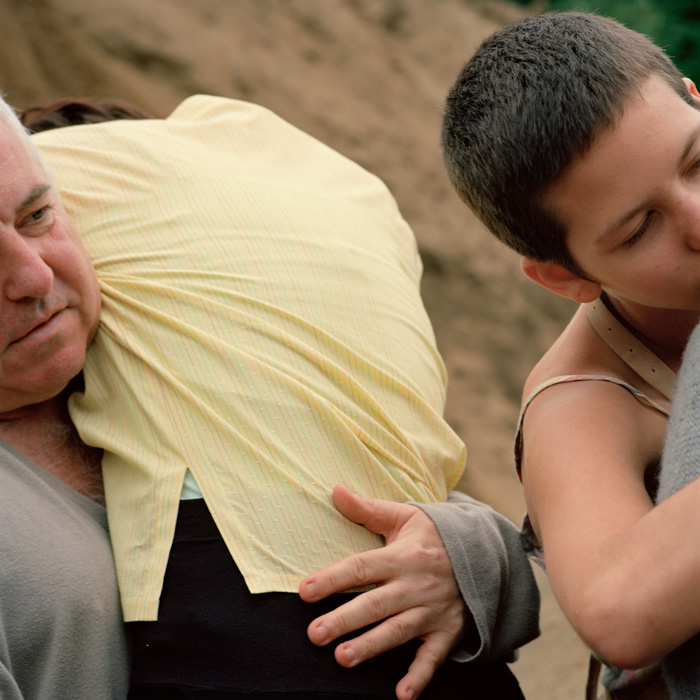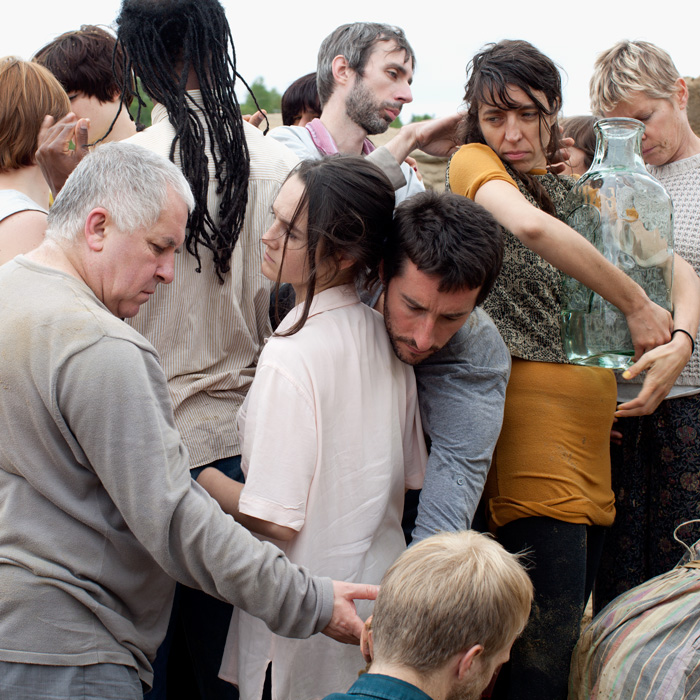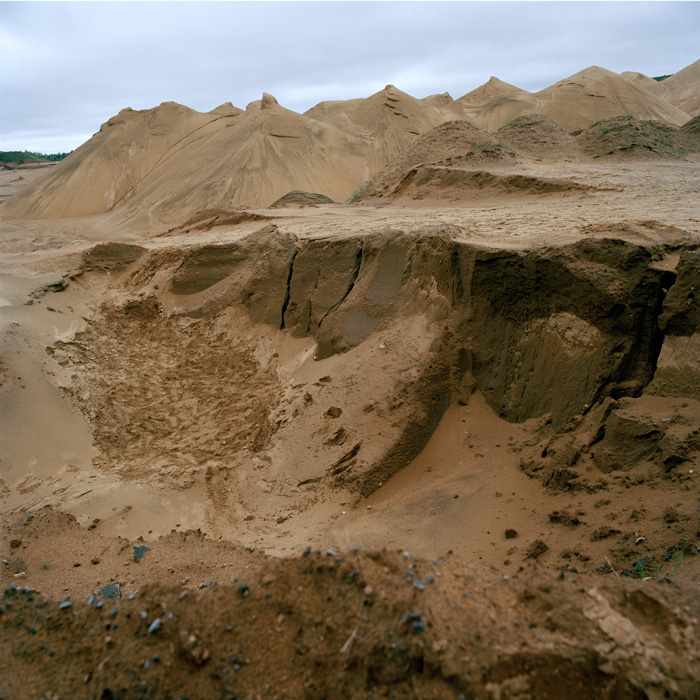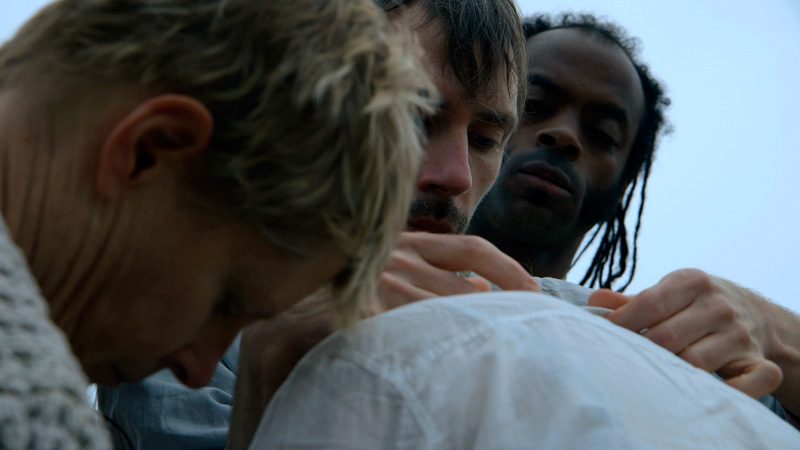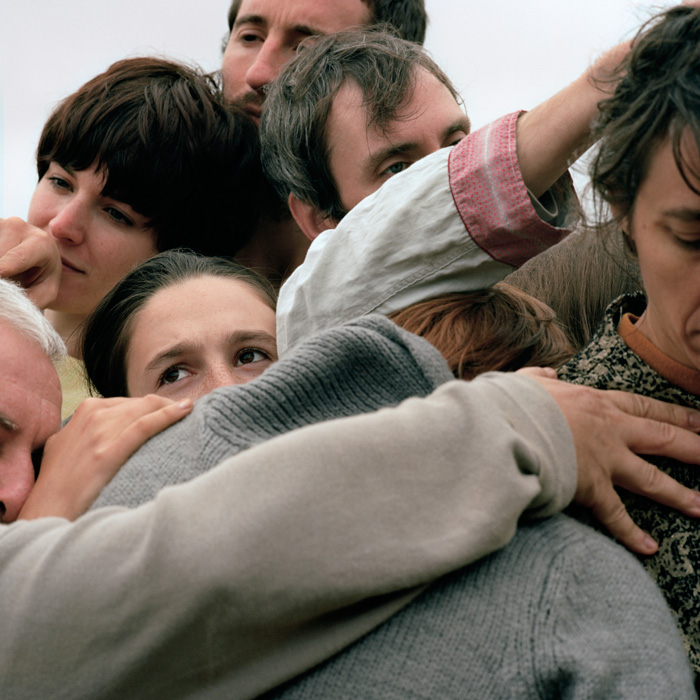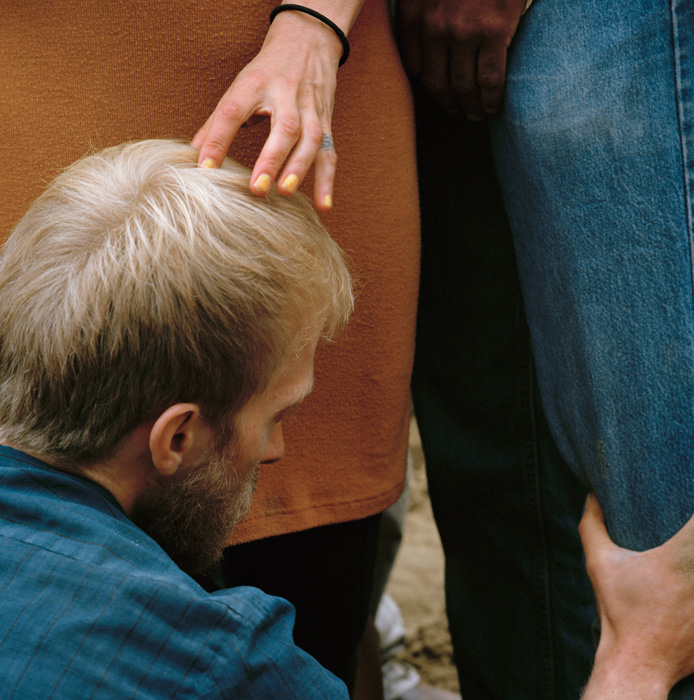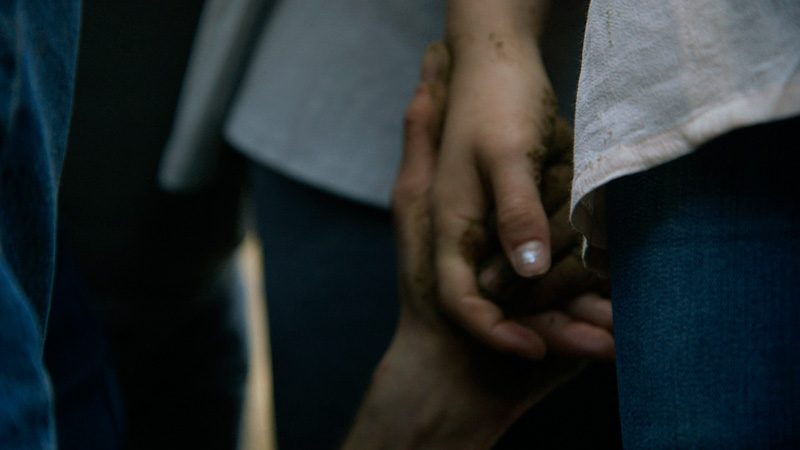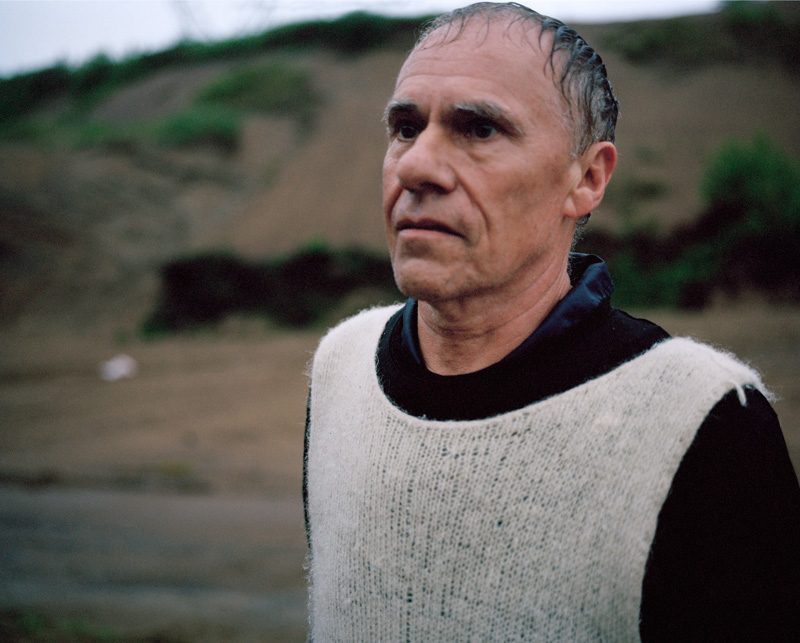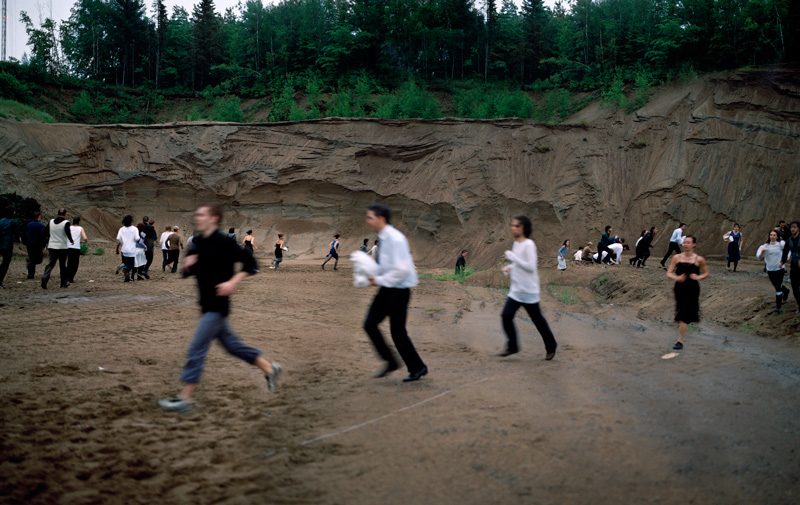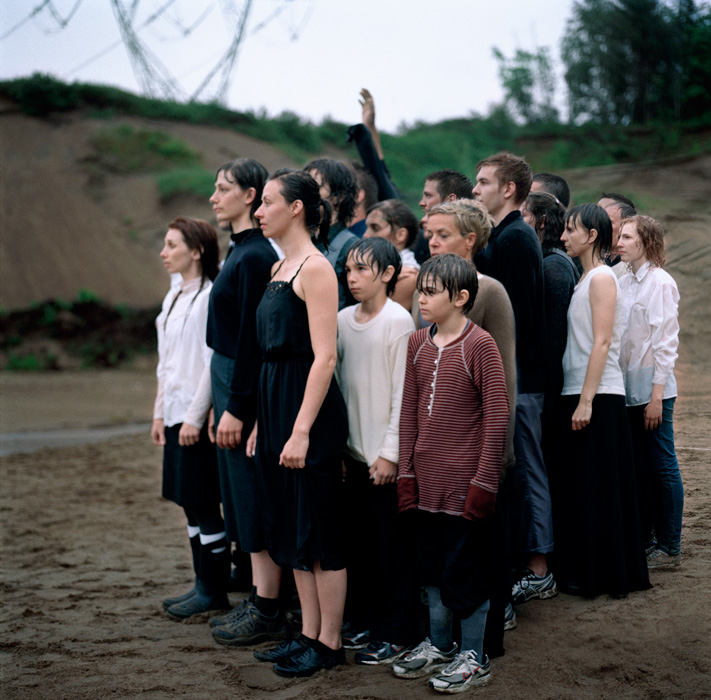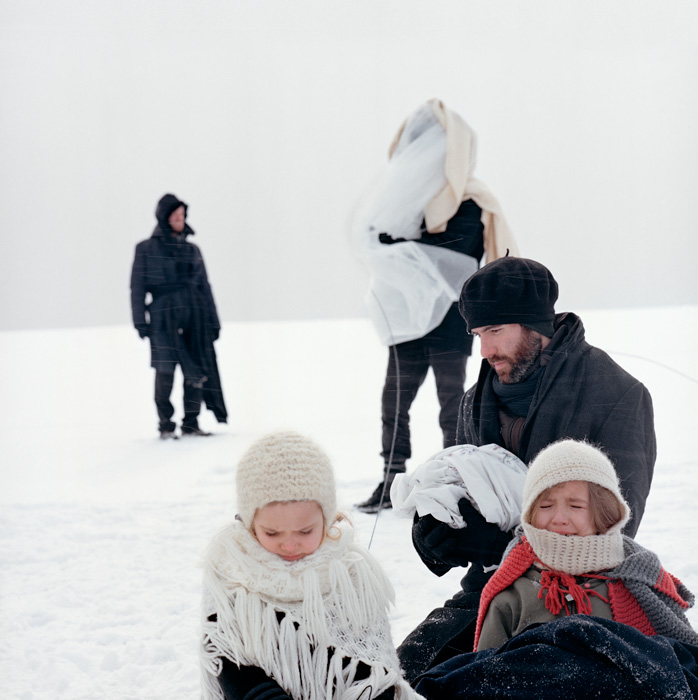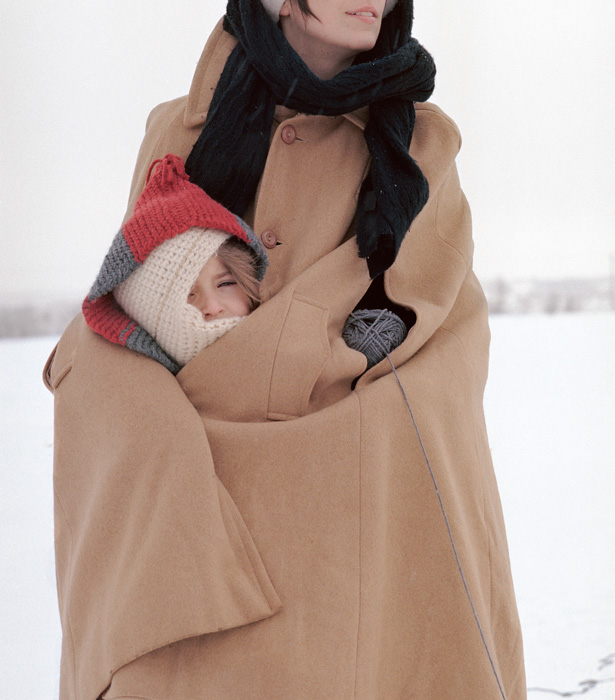[Winter 2014]
by Anne-Marie St-Jean Aubre
Up to now, a certain conception of painting came to mind when I thought of Jacynthe Carrier’s photographic and videographic work, not only because of the emphasis that she places on composition and narration in the creation of her works, but especially because of the type of gaze that these works draw. I say “up to now” because in her new corpus, Les Eux (2013), another avenue seems to have opened up, changing the position assigned to the gaze in the perception of works while weakening the sensorial supremacy of vision as a mode of apprehension of the world. Indeed, although in Scènes de genres 1 and 2 (2009) Carrier used a number of tactics to give viewers an overall perception of the scenes taking place before their eyes, in Les Eux she breaks with this intention by moving their position from the periphery to the centre of the action, and by refusing to bring together in a manageable whole the scattered and fragmented bits that they are given to see. By doing this, she sets the work in a critical – but always poetic – relationship with the precepts underlying a certain comprehension of the modern subject deriving from the Kantian aesthetic, which defines the subject as an autonomous viewer affirming his or her control via his or her gaze, conceived as a privileged tool that acts as the only intermediary linking the subject to the world and responsible for all possibility of rational knowledge.
Turning its back on allegory, Les Eux instead evokes metaphor, making from the human node firmly anchored in a territory an image conveying a certain idea of community.
Between Painting and Carrier’s Work: The Notion of Window. Gérard Wacjman, revisiting Alberti’s famous sentence comparing Renaissance painting to a window open on the world – or on history, after his examination of the source text – insists on taking its full measure in his book Fenêtre. Chroniques du regard et de l’intime, in which he states nothing less than the following idea: “The revolution replete in [Alberti’s sentence] . . . was to institute the modern subject as viewer, viewer of the world, he was to be the master of the visible, by the gaze; but also, by the gaze was instituted what would be the correlate of the taking of power by the viewer subject: it is what we call Reality, the World as Reality. . . . Under the inoffensive guise of comparing the painting and the window, Alberti in fact changed the order of visual reason – thus, both the status of the human being and the order of the world changed. The world now belonged to the one who gazed at it. These were the times that were opening up.”1 Although she is not known for having a painting practice, Carrier’s work has an obvious pictorial quality – and that’s what makes the linkages among window, painting, history, and gaze so relevant.
In another essay, I explored the connections between the “tableau vivant”2 genre and her projects – looking, for example, at the affinities between the Procession series (2010) and the pictorial works of Jean-Paul Lemieux, as well as similarities with the way paintings were hung on the wall at the time of the Salons, and recalling the proximity of the video À l’errance (2010) to the composition of allegorical paintings and commemorative monuments, in which the representation of an abstract idea, heroic epics, and distillation of a historic moment in a strong image are important factors.3 The aesthetic of Carrier’s work, up to the Parcours corpus (2012), thus dialogued directly with the great genres of traditional painting – portrait, landscape, historical paintings, and allegorical paintings – as her photographs and videos put into images how human beings relate to their environment, their capacity for anchorage versus their forced mobility, and their way of affirming their presence by marking the territory; but this is not the issue that I want to discuss here. Rather, I want to pay attention to how the gaze makes perceptible a certain shift in the artist’s practice – a practice that from the beginning has looked at different ways of conveying in visual form a scene first conceived to be performed before her eyes. Carrier’s process of distancing to objectify what she sees is conveyed in the gaze of the camera, which, like the painting and the window, makes a spectacle of the world. And this is in fact the point of Alberti’s trope on which Wajcman dwells: “Not: looking at a painting is like looking through a window, but: looking through a window is like looking a painting”4 – and thus objectifying the world while reformulating it, because the one who looks produces the world by imbuing it with a subjective tint.
On the Interplays of the Gaze. This distant but subjective gaze is found in the great photographic compositions that insist on the constructed dimension of the vista that opens before it, but also in the sequences of images to be read from left to right like a filmstrip negative; this strategy is employed in the Scène de genre series, which situate viewers at a privileged position from which they may sweep the scene with their gaze to embrace its totality and thus reinforce their position as unified subject. Even as it makes tangible the temporality of the gaze, this strategy also reminds us that the senses, far from being neutral, are shaped by the culture in which they are immersed. Crossing the threshold of the photographic image in order to explore its depth, the video À l’errance (2010) adopts, rather, the scrutinizing point of view of a disembodied eye that maintains a mistrustful distance, skimming the surface of the arrangements of mummified bodies and objects frozen in a parallel time dimension. Rites (2011), which somewhat combines such camera movements, compounds the points of view by constantly alternating between close-ups and establishing shots, attempting thus to capture both the scene’s smallest details and its totality – another way of affirming the influence of a gaze that wants to add up everything. As it circulates among the different stages, which are scenes dispersed in the space of the landscape, the camera approaches very close to the protagonists and doesn’t hesitate to pierce the social bubble that is usually respected, yet without asserting the flesh-and-blood body to which the wandering gaze is attached. Although the works adopt, in large part, a logic that makes the viewer into simply a gazer, the protagonists in the works, in comparison, are completely immersed in a corporal experience that calls upon all of their senses – some eating, others moving blindfolded in a field of heat lamps. Given their subject, they thus comply with the position of those who have turned to the sensory in their study of artworks – who, to counter the modern position cited above, advance, with Henri Lefebvre, that “the space we inhabit is not a ‘pre-existing’ world we ‘see,’ but a product of the kinesthetic, perceptual, practico- sensory realm, in which all the senses are employed.”5 Unlike those who take the Kantian position that it is only through vision that the subject can get an idea of the world around him or her, these scholars insist on returning to the senses, and to the body as a whole, the predominant role of mediator for apprehension of the world.
A Turning-point in Carrier’s Practice. With Parcours (2012), the atmosphere loaded with objects, protagonists, and successive actions offering the imagination multiple possible narrative lines is cleared away and, with it, any immediate reference to painting in the image and to the contemporary version of the myth in the representation of subjects – figures with a proud bearing, exemplary rectitude, intense gazes, worn out by life but courageously pursuing their destiny. Suddenly, the direct, physical dimension of bodies experiencing their environment takes precedence, displacing the accent from representation to performance. Continuing along these lines, Les Eux brings to completion the upheaval presaged by the preceding series by embodying the camera’s gaze and, thus, the viewer, who, entangled in the heart of the human interweaving featured in the works, no longer has the power to embrace the action with his or her gaze in order to gain an overall idea. Truncated bodies, a compact mass without context since the view is never raised above the protagonists, and palpating gestures that appear to be made for their own sake and not for the advancement of a story combine to make this new project a more grounded work, less concerned with history and its relation to the mythical forces that tower over it than with human beings in their contingency and immanence. Turning its back on allegory, Les Eux instead evokes metaphor, making from the human node firmly anchored in a territory an image conveying a certain idea of community. Although this subject was previously addressed in the content of her works, Les Eux testifies to a new avenue in Carrier’s practice, in which she extends her exploration to the formal processes of the artwork itself.
Translated by Käthe Roth
1 Gérard Wacjman, Fenêtre. Chroniques du regard et de l’intime (Lagrasse: Éditions Verdier, 2004), 62 (our translation).
2 Literally “living picture” in the sense of reproducing, live, the composition of a picture.
3 See the text accompanying the exhibition Faire comme si… presented at the Musée régional de Rimouski from 26 January to 8 April 2012.
4 Wacjman, p. 183 (our translation).
5 Patrizia Di Bello and Gabriel Koureas, “Introduction. Other than the Visual: Art, History and the Senses,” in Art, History and the Senses: 1830 to the Present, edited by P. Di Bello and G. Koureas (Burlington: Ashgate, 2010), p. 7.
Jacynthe Carrier, born in Lévis, lives and works in Quebec City and Montreal. She holds a bachelor’s degree in visual and media arts from the Université du Québec à Montréal and a master’s degree in photography from Concordia University. Her works have been presented in solo and group exhibitions in Quebec (including at La Triennale québécoise 2011, Manif’ d’art 4, the Musée régional de Rimouski, and the Galerie de l’UQAM). Her videos have been on the programs at events in Europe, Brazil, and the United States. In 2011, she received the Prix à la création artistique awarded by the Conseil des arts et des lettres du Québec; in 2012, she received the Prix Pierre-Ayot. She is represented by Galerie Antoine Ertaskiran. jacynthecarrier.com
Anne-Marie St-Jean Aubre has a master’s degree in art studies from UQAM. In addition to contributing regularly to magazines and other publications, she is the assistant director at SBC galerie d’art contemporain and works as an independent curator. Exhibitions she has organized include Doux Amer (2009), Faire comme si… (2012), Autant en emporte le vent (2012, co-curated with Guillaume La Brie and Véronique Lépine, and Tania Ruiz Gutiérrez. Les figures du temps et de l’espace (2012).

